Best Easy Pizza Dough
This pizza dough recipe sets the foundation for beautiful, flavorful pizzas. It works great in home ovens as well as outdoor pizza ovens. No mixer is needed and you don’t need to proof your yeast.
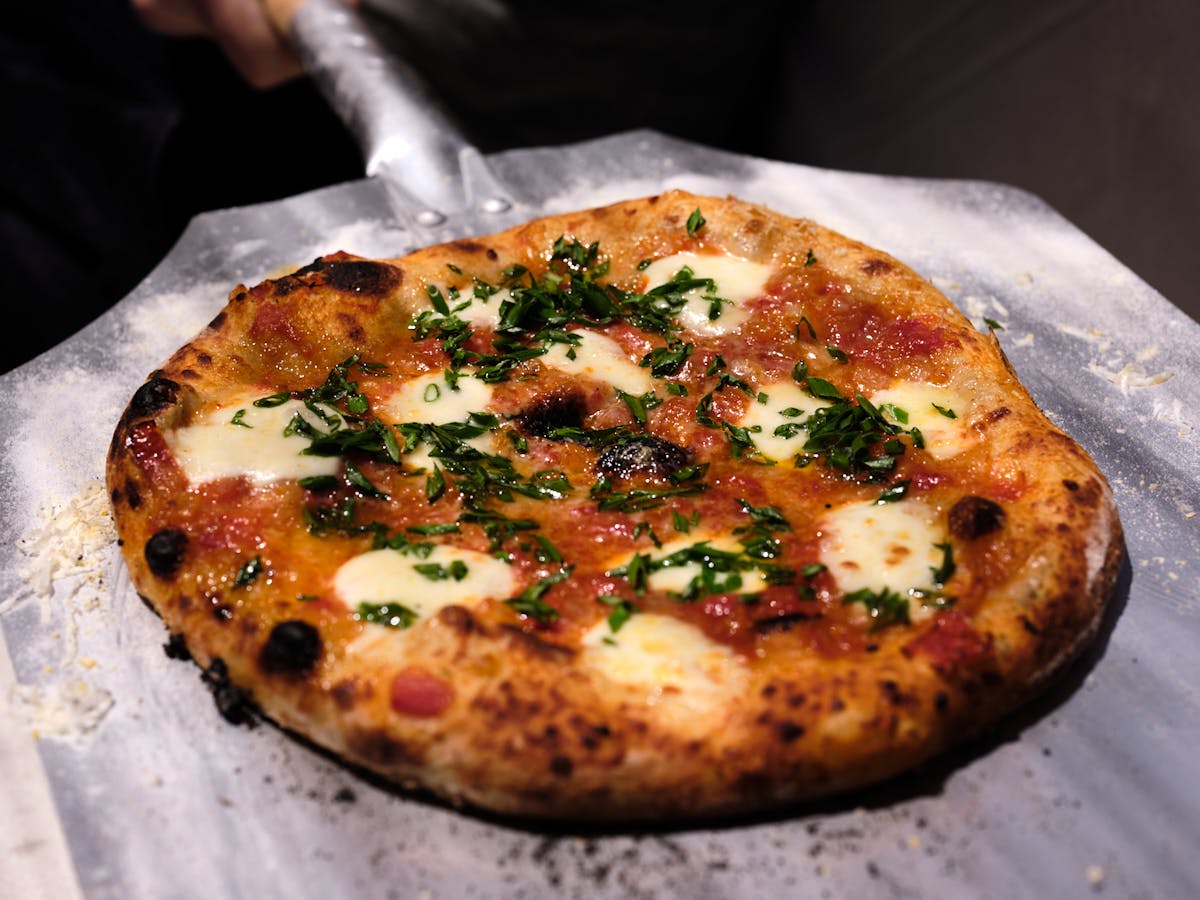
I can make a mean pizza, but it took me a while to learn how. Exceptional pizza starts with great dough and for the better part of the past decade my pizza dough approach stuck close to Peter Reinhart’s Napoletana pizza dough recipe. It makes a beautiful, flavorful crust using a delayed fermentation method. But, in recent years I wanted to ditch the stand mixer and simplify wherever possible. So, things have evolved in a good way!
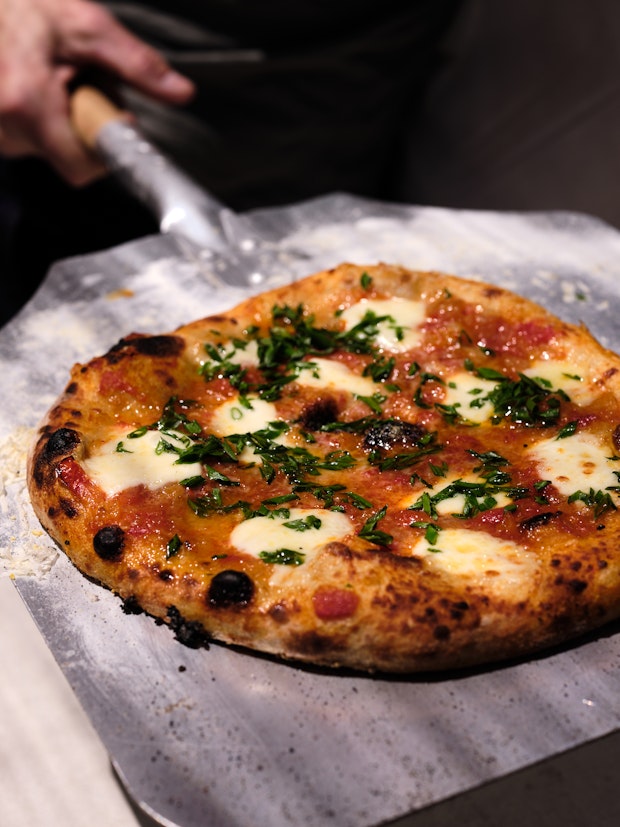
Today, I’m going to share my go-to pizza dough recipe. It’s the simplest recipe I know and delivers beautiful, reliable results whether I’m baking in my kitchen oven, the little Airstream oven(!), or an outdoor pizza oven. No mixer is needed and you don’t need to proof any yeast. It’s such an easy pizza dough recipe and completely delivers.
Pizza Dough Inspiration
Let’s talk about this recipe. In addition to Peter’s Napoletana pizza dough recipe I’ve tried a lot of approaches to pizza dough over the years. One of the recipes I liked (for a lot of reasons) is the Roberta’s recipe that ran in the New York Times. You mix it by hand for a few minutes, rest, mix again, divide, and refrigerate. It’s dead simple. That said, I like the flavor development in Peter Reinhart’s overnight, cold, slow-fermentation. So I now use a bit of a hybrid of the two recipes as my starting point for pizza making. I’m going share where I've landed related to making dough, and then talk you through a lot of the details, because a great pizza dough is just the start. Beyond that, pizza making is almost entirely about approach, technique, and adaptability.
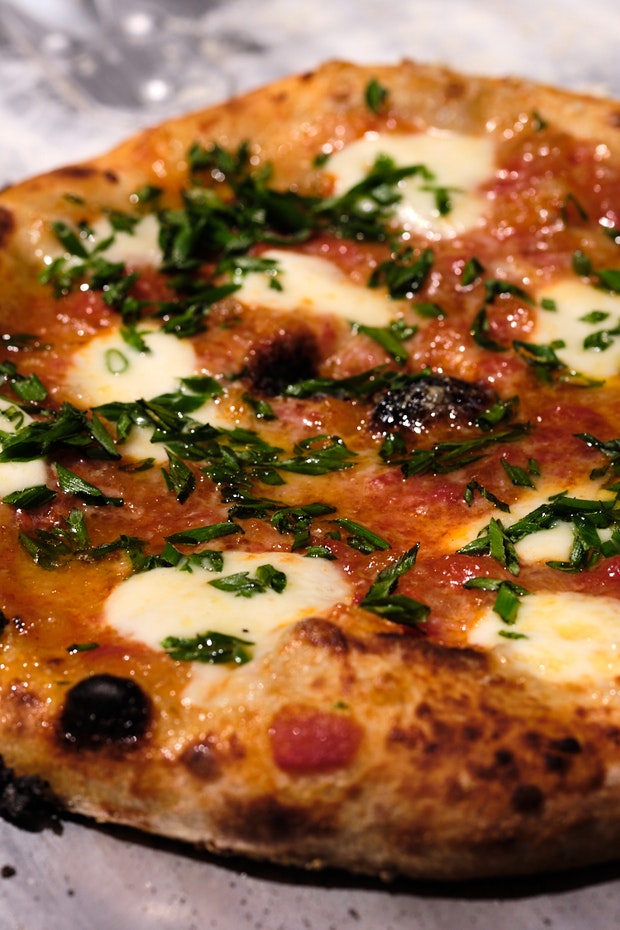
Pizza Dough Ingredients
There are only a handful of ingredients in pizza dough and I’m going to talk through them. There are some easy mistakes to make on the flour and yeast front, and to avoid making them my main advice is to start by carefully checking your labels.
Let’s Talk about Yeast
What kind of yeast should you use in your pizza dough? The Roberta’s + NYT recipe calls for active dry yeast. I’ve come to prefer using instant yeast for a dough like this one. Anthony Falco’s quote in his book Pizza Czar left an impression. He says, “active dry yeast is subjected to high temperatures, so most cells are dead. It’s a ghost ship of yeast cells. Hard pass on active dry.” You can see why proofing active dry yeast is so important. Ghost ship! Not so with instant yeast. I call for instant yeast in the recipe below.
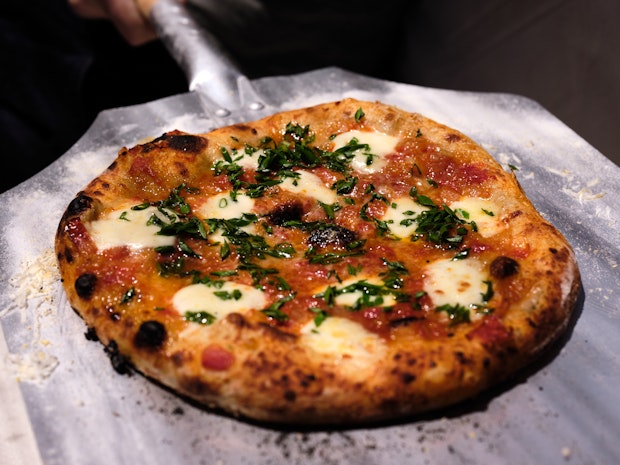
What is the Best Flour for Making Homemade Pizza Dough?
The best flour to make pizza dough with is the flour you have in your kitchen right now. Just go for it. Ideally it would be bread flour, but don’t be detoured if all-purpose flour is what you’ve got. If you think you want to go down a serious pizza-making rabbit hole, grab a bag of bread flour, make a few pies. And then compare those to ones made with some “00” pizza flour. Experimenting is half the fun.
- Bread Flour: With a higher percentage of protein compared to all-purpose flour, this is the flour I’d recommend starting with for a great crust. Bread flour is widely available, and you’ll get fantastic results.
- “00” Pizza Flour - A lot of people swear by a pizza dough made with a percentage of “00” flour. I sometimes go the extra mile and source this flour, but more times than not I’m out of it. I’m here to tell you, it’s okay, bread flour works really well on its own. Also, here’s the deal, there are multiple types of “00” flour. So you need to be extra careful. You’re looking for “00” pizza flour. Not the “00” for pasta. All the “00” flours are ground powder-fine, but you want one specifically for pizza. I include instructions below if you want to experiment in “00” world.
- Unbleached All-Purpose Flour: You can make really good pizza dough with all-purpose flour. In fact, the pizza dough recipe in my 1984 edition of Chez Panisse: Pasta, Pizza, and Calzone calls for unbleached all-purpose flour. You'll likely prefer results when using a flour with higher protein content - bread flour, and/or “00” pizza flour - but there are still a lot of APF fans out there.
How To Make Homemade Pizza Dough
There are a lot of variables, and a lot of questions related to the details of making dough at home. I'm going to talk through a bunch of them here. The main objective with this recipe was to create an easy-going pizza dough that is simple to make and easy to shape and handle. I wanted the resulting pizza crust to be a bit rustic, with some bubbles and topography and good texture when baking - even when pulled quite thin. I'll give you the ingredients as weight, so a basic kitchen scale is needed. I'm not requiring it to be difficult, it dials in your dough in accurately. You can really feel the difference if your flour or water are off.
Can this Pizza Dough be Used in a Pizza Oven?
Yes! It does great in dedicated pizza ovens, for example - when the weather is good- we use an Ooni 16. I’ve found the best results happen when we pre-heat the oven for 45 minutes on maximum heat. Launch your pizza onto the stone, and then dial back the heat to the lowest possible setting. Turn your pizza using a peel or tongs to avoid burning. It takes some practice, make extra dough when you're starting out!
Can this Pizza Dough be Used in a Standard Oven?
Yes, flip the convection switch if you have one. If not, no big deal. As far as oven temperatures go - I have great results at 450F degrees (or higher) WITH a pizza stone. Go buy a pizza stone immediately if you are serious about making great pizza at home. They are cheap and make a huge difference in your crust.
How Do I Keep my Pizza Dough from Sticking
I’ve learned this the hard way. First thing, if you’re baking on (or in) a pizza pan, sheet pan or baking sheet (below), you don’t need to worry about starting with a floured surface. Rub a bit of olive oil across the pan, shape the dough in the pan and you’re ready for toppings. Things only get trickier if you’re attempting to prepare a pizza and then transfer it to a pizza oven or onto a pizza stone in your oven which is what we'll talk about next.
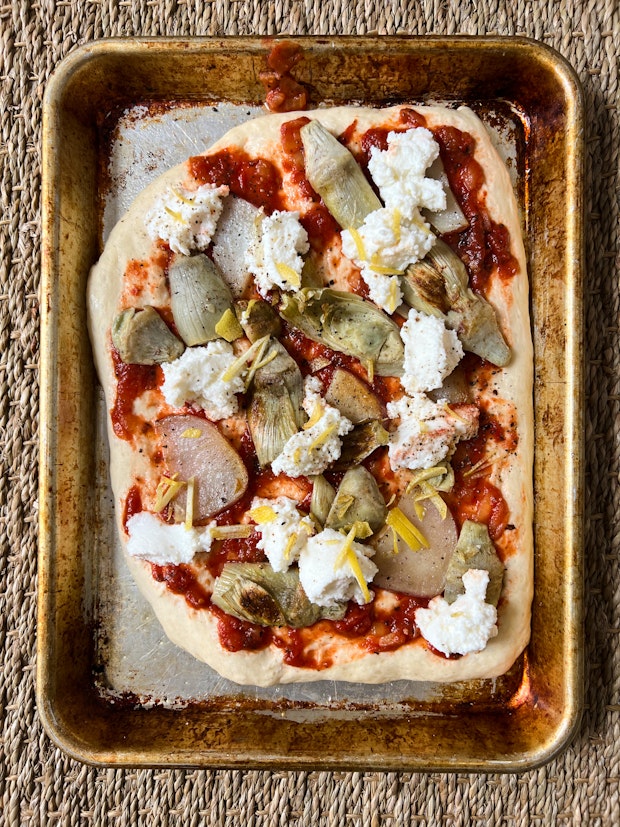
Be nice to your future self. One way to keep pizza dough from sticking to your pizza peel, is to prepare a floured surface. I’ve found that a bit of care and attention at this step pays dividends down the line. It’s a balance, you don’t want your pizza to stick to the pizza peel, because then you can’t get it into the oven. But you also want to keep extra flour or cornmeal to a minimum, because it burns up and can leave off flavors on your pizza. Here’s my approach:
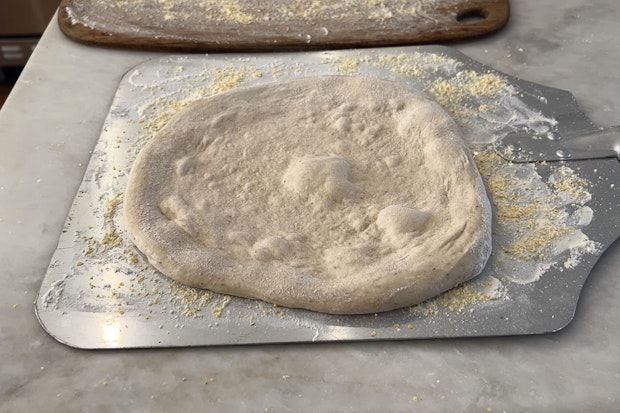
Prepare your pizza peel: Use your fingertips to rub flour into your pizza peel. Like, really rub and work it in. Then tap off most of the extra. Add a small amount of cornmeal, just enough to help the dough a bit separate from the surface of the peel. See all that extra flour and cornmeal around the dough (up above)? Brush it off before attempting to launch your pizza into the oven. In fact, now that I'm looking more closely at that shot, I'd recommend using half the cornmeal you see there. Too much, my bad. I'm sure it burned right up.
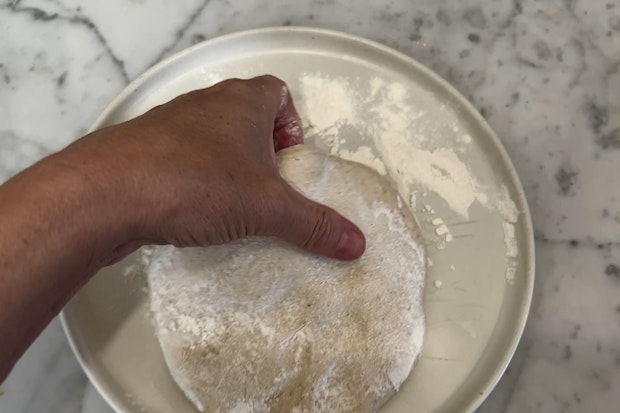
Prepare Your Dough: When your dough is ready, and just before you want to bake the pizza here’s what you want to do: place some flour on a plate. Gently, and without over-handling, transfer the dough onto the plate. Flip it and coat the other side of the dough. You want to cover any sticky spots with a light coating of flour. Gently, but working quickly, pick the pizza dough up and begin to work it into a circular shape, dusting off any extra flour while you’re at it. Gingerly stretch and arrange on your prepared pizza peel. Give the peel a bit of a shimmy to make sure the dough isn’t sticking in any spots. Proceed with toppings and get the pizza in the oven sooner rather than later. The longer it stays on the peel, the more likely it is to stick.
What if I Don’t Have a Pizza Peel?
I didn’t use a pizza peel until I bought an outdoor pizza oven. And I've replaced the peel in the photo (below) with the same one, only smaller. It's easier to maneuver inside the small oven. That said, you can grab anything thin and flat (not plastic), flour it and add a bit of cornmeal (see notes above), prepare the pizza, and then launch it onto the pizza stone. A thin bamboo cutting board always did the job well (still use it). The backside of a flat baking sheet can also work, but I go for the one with barely any lip - you want your pizza to sail off the “peel” not drop off a cliff.
Pizza Topping Strategy
I'm going to leave you with my favorite pizza dough recipe, it's up to you to play around with the toppings. The best advice I can give you is to take it easy on that front - a little goes a long way. One of my favorites is a simple pizza margherita pizza made with this tomato sauce, a few torn up mozzarella balls, and a few pinches of salt before placing the pizza in the oven. And, don't forget the magic touches. When the pizza is hot from the oven, give it a quick dusting of freshly grated Parmesan, a tiny drizzle of artisan-quality virgin olive oil, and a sprinkling of basil cut into a chiffonade. Serve pronto! Some other topping ideas to follow, and here's a page with an extended list of pizza topping ideas.
Pizza Topping Ideas
I keep a notebook of all the favorite pizza toppings we've done in the recent past. Some favorites include:
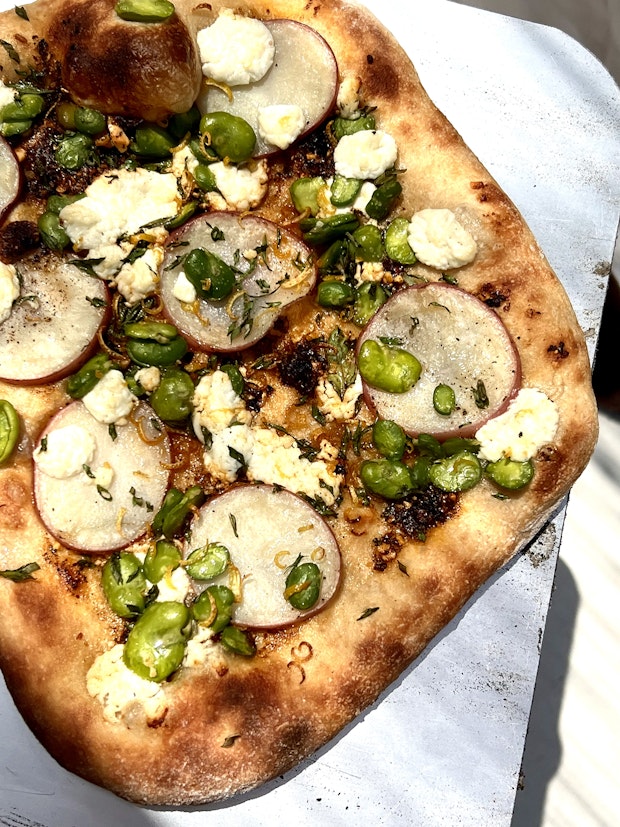
- Chile Crisp Potato Pizza: I love a potato pizza. This one (above) was a chile crisp oil like the one by Fly By Jing or KariKari, thinly sliced balanced potatoes, ricotta, fava beans, and lemon zest. Finish with lemon olive oil drizzle and chives.
- Artichoke Heart Red Pizza: Tomato sauce, thinly sliced blanched potatoes, sautéed artichoke hearts, goat cheese, lemon zest (picture above prepped on a sheet pan)

- Artichoke Heart Spring Pizza: Olive oil or pesto, sautéed artichoke hearts, mozzarella, shallots, fava beans, lemon drizzle, grated Parmesan. Pictured directly above.
- Chana Masala & Chickpea Pizza: We make this one a lot. Tomato sauce made with lots of caramelized onions and heavily spiced with chana masala spice blend (or sometimes garam masala), chickpeas, dollops of low-fat yogurt (it works better than full-fat here for some reason), tons of crushed nutritional yeast kale chips on top after pizza comes out of oven, drizzle of lemon or basil olive oil when pizza comes out of the oven.
- Cherry Tomato Kosho Pizza: Kosho or other citrus garlic paste, cherry tomatoes, chickpeas, chives, and slivered basil with a drizzle of tangerine oil after it comes out of the oven.
- Meyer Lemon Pizza: Inspired by my favorite pizza ever, at Bettina in Santa Barbara, CA. Ricotta cheese dollops, pickled red onion, thinnest slivers of whole Meyer lemon, pistachios.
- Paneer & Pea Pizza: Turmeric-marinated paneer, scallions, chickpeas, sautéed artichoke hearts, tomato sauce, peas, a bit of crumbled goat cheese, serrano chiles, and lots of chopped cilantro after the pizza comes out of the oven.
Same Day Pizza Dough
If you like to wait until the last minute to make pizza dough, here’s what I’d do. Use warm water (115℉) instead of the ice water called for in the recipe. Follow the recipe directions, divide and shape the pizza dough balls, and then allow the dough to rise at room temperature for 3-4 hours. You should be good to go. That said, I strongly prefer the overnight method. You end up with a golden, beautiful crust with the perfect amount of crunch and subtle yeasty undertones.
Favorite Tomato Sauce for Pizza
This is my favorite simple tomato sauce, and I use it on many of my red sauce pizzas. My one pro-tip is to make it ahead of time. Make sure it’s not hot. If the sauce is still warm when you're topping your pizza, the dough is more likely to stick.
Wildcard: Consider Flavoring your Pizza Dough
Aside from swapping in a percentage of whole grain flour on occasion, I tend to limit my dough ingredients to flour, yeast, salt, water, and a bit of olive oil. That said, sometimes I’ll add ingredients to the dough to bring an added flavor component to the party. Playing around with dough add-ins is a lot of fun. My favorite thing to add is lemon zest. You can also add herbs like thyme or oregano - fresh or dried. You might add chopped olives, or chopped sun-dried tomatoes. Grated cheese is fair game, or even tiny cubes of Gruyere. The directions you can go in are endless.
How to Double your Pizza Dough Recipe
There is sometimes confusion related to scaling up baking recipes. This recipe is very straight-forward. Double all ingredients including the instant yeast.
Pizza Dough Time-saving Tip
If I know I want to make pizza dough, I try to remember to chill water in the refrigerator in preparation ahead of time. It gets the water down to about 40F, cold enough to make the dough, and then I don’t need to mess around with ice cubes.
Pizza Dough Resources
There are an abundance of amazing cookbook and baking books out there covering the topic of pizza dough and pizza making. There are also fantastic bread and sourdough books that delve into the topic of pizza dough. Here are a few of my favorites. Many of them use natural sourdough as a leavener, which we’re not covering today. I’ll do a separate post on sourdough pizzas at some point down the line. If you want to do a deeper dive on the how’s and why’s of pizza dough, here are some great resources:
- The Bread Baker’s Apprentice: Mastering the Art of Extraordinary Bread by Peter Reinhart
- Pizza Quest: My Never-Ending Search for the Perfect Pizza by Peter Reinhart
- Tartine Bread by Chad Robertson
- Pizza Czar: Recipes and Know-How from a World-Traveling Pizza Chef by Anthony Falco
- Mastering Pizza: The Art and Practice of Handmade, Focaccia, and Calzone by Marc Vetri with David Joachim
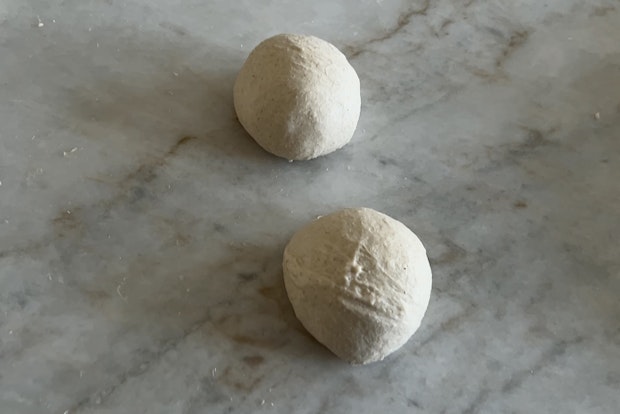
How To Freeze Homemade Pizza Dough
If, after mixing up your pizza dough and refrigerating it overnight, you don’t think you’ll be using it in the next couple of days, transfer the dough to the freezer (still in a plastic bag or wrapped tightly with plastic wrap) and use within a month.
How to Thaw Frozen Pizza Dough
To thaw frozen pizza dough transfer the dough to a countertop and allow to thaw completely and then come to room temperature before using.
Have fun, and let me know your favorite pizza toppings in the comments please!
Best Easy Pizza Dough
I’ve tested this recipe with a range of flours. The pizza made in the lead photos were made with King Arthur Bread flour (12.7% protein). I’ve also had great results using half bread flour and half “00” pizza flour 12-13% protein. You can also use 100% “00” pizza flour. If you’re going this route be sure to source “00” pizza flour, not “00” pasta flour. Also, please note that I call for instant yeast here, not active dry yeast which allows you to proceed without the proofing step. To double the recipe, double all ingredients including the yeast. This recipe makes enough dough for two generous personal pizzas. To double the recipe, double all ingredients including the yeast.
- 300 g bread flour, plus more for dusting
- 1.5 g instant yeast (~1/2 teaspoon)
- 7 g fine grain sea salt (scant 1 teaspoon)
- 200 g ice-cold water
- 4 g extra virgin olive oil
-
Whisk the flour, yeast and salt together in a large bowl.
-
Add the cold water and olive oil and stir to combine.
-
Turn the dough out onto a counter, and knead for about three minutes. Allow the dough to rest for 15 minutes.
-
Knead for another 3 minutes and then cut the dough in half. Shape each piece into a ball pulling the ball toward you to develop a bit of surface tension.
-
Rub a small amount of olive oil on each ball then transfer each to a small container or plastic sandwich bag. Refrigerate overnight. The dough can be used after the overnight rest and kept up to three days.
-
A couple hours before you’re ready to make pizza, bring the dough to room temperature, this usually takes about 2 hours. I look for bubbles and loftiness in the dough.
-
Shape your pizza dough (I talk through all my favorite tips up above), sauce, and arrange your toppings.
-
Bake in the hottest oven you have, preferably on a pizza stone. If you’re using a home oven 450F and a pizza stone will get you impressive results.
Makes two 250g pizza dough balls.


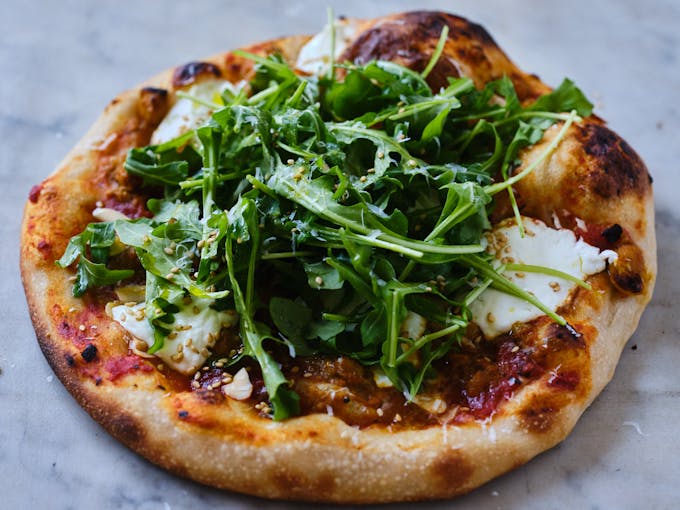
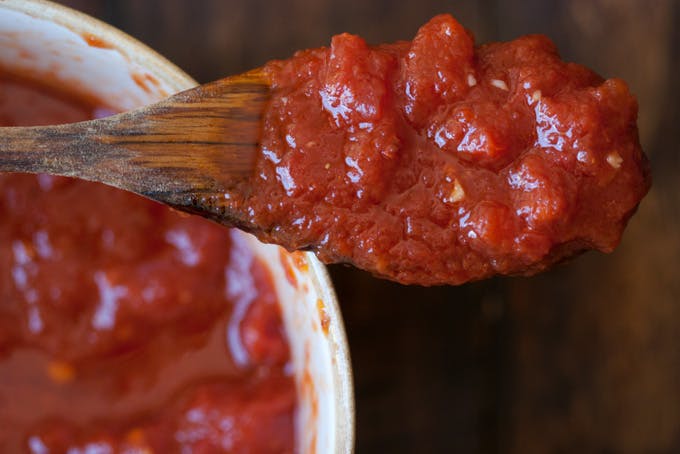
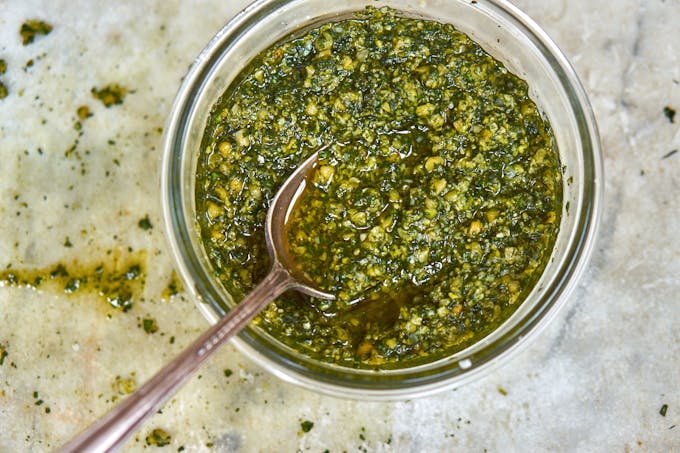


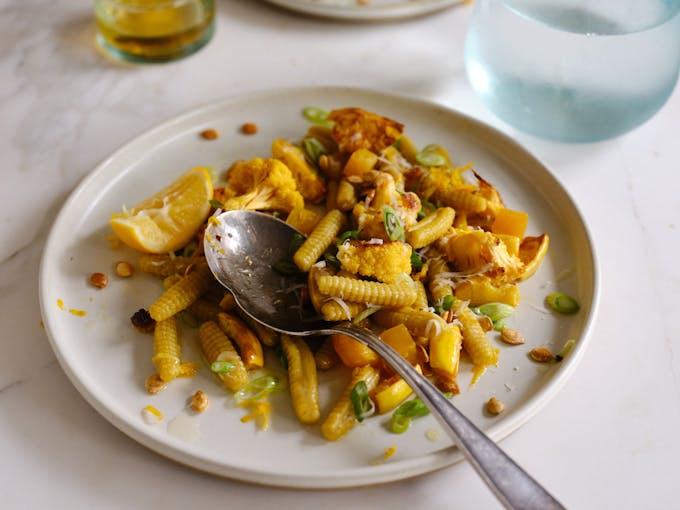
Post Your Comment
Comments
What a great recipe! I've made it twice now, and it's been perfect for pizza and garlic bread. I used half bread flour and half “00” pizza flour and it was just right. Thanks for sharing!
Thanks Kim!
i love this. thank you
I just tried this Best Easy Pizza Dough recipe and the dough was so simple to make and came out perfectly soft, chewy, and flavorful. Thanks for such an amazing recipe!
Did this recipe change or get updated? I’ve been using this recipe for the last 10-12 years and the portions seemed to have changed and it used to translate from grams to cups.
Hi Jessi - yes. I talk through the progression in the post up above. My approach has evolved a bit over there years, and I figured it was time for an update.
I’ve been using a pizza stone but recently have gotten a 1/4” thick pizza steel. It’s great, its a better heat conductor and retains better temperature stability. I just made your dough and loved the taste. Can’t wait to try some of your toppings Thanks for all the info you have posted everything helps.
Thanks Susan!
If I want to use a stand mixer instead of knead the dough by hand, what do you suggest? What speed and for how long? Thank you!
Hi Erin - hmm. Try the same schedule, use the dough hook attachment and cut each of the "3 minute kneading periods" down to about 1 1/2 minutes, on medium speed each.
Great pizza story. I bought instant yeast and bread flour specifically for this recipe, but by the time I got around to trying it I couldn't find the yeast (new house, don't know where I'm keeping everything yet...) and so all I had was a bag of "ghost ship" "active yeast" from five years ago.(!) in the refrigerator. Figuring it might not rise, but at least leave a bit of a yeasty smell and flavor I proceeded to make the dough with 20% ground whole wheat, then I added the bread flour, and that's the bag that the instant yeast was also in, sooo, the recipe was so simple I made another batch with the instant yeast and 20% rye flour and baked them both up. Both came out great, but I did use 3 times the ghostship variety, just in case. A few bodies must have still been clinging to life as we still got a rise. Both rested for 3 hours on the counter before baking. This was an entertaining and informative recipe post, which is the best kind. Thank you, Heidi! We will definitely be making more pizza in the future with our own crusts now.
Love this Janet!And so happy both yeast delivered lol. Here's to pizzas all summer!
What a lovely useful post!!
Thank you!
Just wanted to say thanks, fabulous recipe!!! I have now made my best pizza dough ever!! Really appreciate it.
Yum, this looks delicious!
Now I'm inspired to make this pizza dough. It looks easy and fantastic. Yum. I've always had problems with pizza dough, so I'll have to give this one a try. Thanks for the recipe!
Damn, that's a fine-lookin' pizza!
Hi Heidi - you've given me an excellent reason to read Peter's book again, your pizza looks 'best ever' indeed!
American Pie is a very good guide. I'm half way through it. All the recipes are tasty. His other books are worth it too!
I'm a big fan of this recipe already! His recipe and your version both say that it can be left in the fridge for up to three days, but I find that I actually like it best if it's been in cold fermentation that long. Overnight is great, but that's become my "quick" version. (sad, isn't it?) Two or three days in the fridge in the same way you say to prep them for the freezer, and this is EVEN MORE heavenly. I've never made it without the oil either, and I don't think I'll bother trying! And last, I had to give up on peels and flour/cornmeal. I have good luck with parchment paper, and I just have to make sure there's not a lot of extra paper around the pizza so it doesn't catch on fire. (I guess it's all the same problem with fiery things.
Yum. How gorgeous that looks. After years of smelling burning cornmeal, I've switched to dusting my peel with flour; works great. Here's a topping idea that won me 1st place in a local pizza contest: a little bit of purchased alfredo sauce, sliced mushrooms sauteed with fresh thyme, caramelized sliced onions, spinach sauteed with garlic and top off with some crispy cooked, crumbled bacon (cook the mushrooms in some of the bacon fat).... and mozarella of course...v p.s. B-4 it goes in the oven, I like to brush the rim of pizza dough with garlic-flavored olive oil and sprinkle with flakey salt.
It's neat to see Peter receiving praise. He's a teacher at my school, Johnson + Wales University, in Charlotte, NC. Though I'm not in the culinary dept., all of my friends that are constantly talk about how great of a teacher he is. Oddly enough though, he doesn't teach bread class. Bizarre huh?
For some reason, everyone says it's the water that makes the difference... I don't know. But for a thin crust in an electric oven (that will never get like a wood oven crust) just one rise is good. For a higher crust, punching the dough down and letting it rise again for an hour gives a thicker crust. An Italian housewife taught me (1) to put the oven at the max, whatever that is, and never open in the first five minutes (myth?). (2) To get a raised crust on the pizza you should leave it untopped around the edges, and that's where the raised crust will form (wherever there is no sauce). (3) Using a rolling pin compacts the dough and it will "contract" in the oven, rather it should be gently enlarged with the hands and finger tips (or spun around over your fists and thrown up in the air for fun if you can swing it! I can't!!!)... I've found with her advice, my pizzas always come out wonderfully...In Italy. In the U.S. I just can't seem to make them work!!!!! The son of a very successful baker in the DC area gave me Carol Field's The Italian Baker as a gift because his father learned to bake from her. It is a very good book for pizza, also (and her book Focaccia for focacce). I have had great success with her recipes. 3LC
How about whole wheat? Have you tried substituting whole wheat flour for some of the flour? I guess you couldn't get it quite as light and crispy that way, which is a shame.
Hi Anne - yes! I'd start by substituting 20% of the flour for a whole grain flour like wheat or rye to start. Then experiment from there.
More Recipes
Weekly recipes and inspirations.
Popular Ingredients